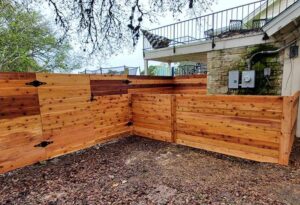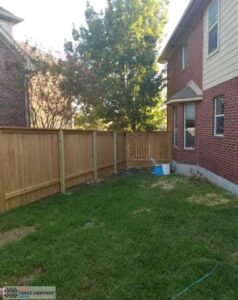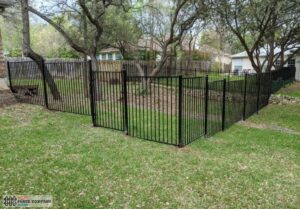811 Utility Mark-Out & Fence Planning in Austin: A Homeowner’s Guide
TL;DR:
Calling 811 before any digging is the easiest way to avoid costly, dangerous utility strikes. In Austin, your locate ticket sets a short timeline for utility owners to mark gas, electric, communications, water, and sewer. Use those marks to fine-tune your fence layout, post spacing, and gate footing strategy—especially near corners, driveways, and irrigation lines. If you want a fence plan that respects utilities, HOA rules, and Austin’s clay soils, the team at Atlas Fence Company will map it all out and handle building your fence to code. To ensure safety and compliance when building, remember to call 811 to fence austin.
Table of Contents
ToggleWhat an 811 ticket is and why it matters

An 811 ticket is a legal notice to utility owners that you plan to dig. They respond by marking the location of buried public utilities on and along your property so you can avoid them when setting fence posts and gate foundations.
Calling 811 is a free service—there is no cost to homeowners for requesting utility markings.
Striking a line is more than an inconvenience—it can be dangerous, delay your project, and create expensive repairs or fines. A clean ticket and a layout that respects those marks, including all underground utilities, is the foundation of a safe fence build.
How the mark-out process works in Austin
When you submit an 811 request, the one-call center notifies affected utilities. Each utility (or its contractor) will visit and place temporary paint and/or flags showing the approximate route of their lines. These are called mark lines, and they indicate the location of underground utilities. Respecting these mark lines is crucial for safety, as it helps prevent damage, outages, and safety hazards during excavation projects. Typical timeline windows are short, so plan your fence schedule to allow time for business days to accommodate utility responses :
- Ticket submission (you or your contractor)
- Utility responses (marking within the statutory window)
- Clarifying questions from locators if access is blocked or gates are locked
Once marks are down, protect them. If rain fades paint or yard work removes flags, call for a re-mark before digging resumes.
Understanding utility color codes at a glance
You’ll see a rainbow in your yard—each color represents a different service. Be sure to avoid areas where a tree might interfere with utility lines.
- Red – Electric power
- Yellow – Gas, oil, steam
- Orange – Communications (phone, cable, fiber)
- Blue – Potable water
- Green – Sewer and drain lines
- Purple – Reclaimed water, irrigation (municipal)
- White – Proposed excavation (used to outline your planned fence line)
These colors mark routes, not the exact edges of a trench.
Reading flags and paint—tolerance, depth, and accuracy
A common misconception is that marks show precise locations and depths. In reality:
- Tolerance zones apply—typically two feet plus the pipe diameter on either side of the mark.
- Depth is not guaranteed. Soil movement, prior grading, and landscaping can change cover depth; never assume a fixed number of inches.
- Changes happen. Construction in your area may have rerouted utilities; fresh marks beat any old as-builts or guesswork.
Keep in mind that 811 markings have a limited scope and may not include private utility lines or systems beyond the property line.
Approach the marked corridor like a no-post zone unless you’re hand-exposing and verifying the location with the utility owner’s guidance.
Property considerations: boundaries, easements, and site-specific factors

Before you break ground on your next fence or digging project in Austin, it’s crucial to get familiar with your property lines, any easements, and the unique conditions of your yard. Texas law requires homeowners to know exactly where their property begins and ends, and to be aware of any underground utility lines that might be running beneath the surface. Overlooking these details can put you, your neighbors, and your community at risk.
Easements are designated strips of land—often along the property line—where utility companies have the legal right to access and maintain their underground facilities. These areas may contain power lines, natural gas, water, or other utility lines, and digging in these zones without proper precautions can lead to serious injuries, service outages, or costly repairs. That’s why Texas law requires homeowners to contact 811, a free service, before starting any planned excavation. When you submit a request, utility companies will mark the approximate location of their underground utilities with paint and flags, helping you dig safely and avoid hidden hazards.
It’s not just about the lines you can see. Site-specific factors like soil type, slope, and existing landscaping—such as trees or a sprinkler system—can all impact your project. For example, installing a new fence or planting trees near marked lines requires extra care to avoid damaging underground utilities. If you’re planning to install or repair a sprinkler system, be sure to consider the location of all marked lines and plan your digging accordingly.
Remember, Texas law requires a minimum wait of two business days (excluding weekends and holidays) after you contact 811 before you start digging. This gives utility owners time to mark their lines and helps protect everyone involved. Hiring a qualified contractor who understands these guidelines and the risks of excavation is always a smart move—they’ll know how to plan around underground utilities, easements, and the specific needs of your property.
Ignoring these steps can result in injuries, property damage, and even legal trouble. By following the guidelines, using the free 811 service, and respecting all marks and easements, you’re not just protecting your own project—you’re helping keep your entire community safe. So before you dig, install, or plant, take a moment to plan, contact 811, and make sure your project is set up for success.
Planning post locations around buried lines
Once marks are down, refine your fence plan:
- Shift post centers outside tolerance zones; minor adjustments in panel width are often imperceptible once the panel is built.
- Where the line runs parallel to the fence, reduce post spacing slightly or use shallower alternates (e.g., surface-mounted bases only when approved) to keep excavation away from the corridor.
- At crossings, hand-dig and gently expose the line with a dull spade or vacuum excavation, then bridge with a modified footing (offset bell or split footing on either side) to avoid bearing directly on the utility.
- Confirm property boundaries before finalizing post locations to avoid legal or construction issues.
This is where a pro layout shines—our crew will adapt rail spans, gate widths, and footing geometry to miss utilities without producing wavy sightlines.
Gate posts, driveways, and higher-load footings
Gate hinge posts and driveway returns carry more load than line posts. In Austin’s clay soils, we usually spec deeper, wider footings and sometimes bell shapes to resist heave and lean. The choice of materials can also impact the design of posts and footings, so be sure to consider materials alongside other factors when planning your project. If a utility mark for natural gas runs near a planned hinge post:
- Slide the gate a few inches to clear the tolerance zone, or
- Convert a single broad leaf to a double-leaf to move hinge loads away from the mark, or
- Consider a sliding gate where swing clearance or subgrade conflicts exist.
For brand-agnostic build details and how we size posts/footings here, see our fence installation overview as a reference while you plan.
Irrigation, drainage, and homeowner-installed lines
811 protects public utilities and marks near your property line. It does not locate your private systems:
- Irrigation laterals and control wires
- Low-voltage lighting
- Homeowner-installed drains (French drains, downspout lines)
- Private gas lines to grills or fire features
Map these before the crew arrives. Run your irrigation manually to spot head locations, trace control wires from the valve box, and lift a couple of grates to see drain routes. If a private line can’t be located, plan to hand-dig and be ready to cap/relocate sections during the build.
What happens if a line is hit—and how to avoid it
If a suspected utility is damaged:
- Stop work immediately.
- Evacuate the area if gas is involved; call the utility and emergency services from a safe distance.
- Do not bury or conceal damage—utilities need to inspect and repair.
Repairing fences or other structures that involve digging also requires contacting 811 before starting work to ensure safety and compliance with regulations.
Avoiding strikes comes down to disciplined layout, respect for tolerance zones, and hand exposure where line crossings are unavoidable. We schedule utility-aware crew briefings before setting the first post so everyone understands the no-dig corridors and the importance of knowing how to dig safely.
If prior storm movement or age has already compromised boards or posts near a utility corridor, we’ll factor targeted fence repair into the plan so the area remains safe and stable while we work around marked lines.
HOA, permits, and neighbor coordination
Many Austin neighborhoods—and surrounding cities—use HOAs to govern fence height, style, and visibility near easements and rights-of-way, even on holidays. Utility marks often coincide with rear or side easements, which can influence your fence’s exact location or footing style. Calling 811 before digging helps protect the safety and well-being of local communities by preventing utility damage. For a plain-English overview of how HOAs and local rules interact with fence projects, scan our guide to Fence Regulations & HOA Rules in Austin, and we’ll incorporate those expectations into your layout and packet.
Give neighbors a heads-up, especially on shared lines. Coordinating access gates and trash-day logistics reduces stress and keeps utility areas clear for locators.
Build sequencing that keeps your project moving.

Good sequencing blends safety with speed:
- Ticket first, layout second. We sketch your planned line in white paint so locators know where to focus.
- Corner posts and gates are set after the crew leader walks the marks and confirms clearances.
- Hand-dig or vac expose at planned crossings; photograph exposed lines for the job record.
- Set rails/panels after gate posts are verified and concrete tops are shaped to shed water.
This rhythm minimizes rework and protects both the schedule and subgrade.
Always ensure each step in the build sequence is completed before moving to the next to maintain safety and efficiency.
After the dig: protecting marks and documenting layout
Marks fade. Before they do:
- Take photos of each side of the yard with flags and paint visible, as well as close-ups at crossings and gate posts.
- Note any depths you hand-exposed (even if approximate) and store with your project documents.
- If a re-mark is needed mid-project, reference your photos to explain what changed.
Documentation helps future service providers (and you) avoid surprises when adding landscaping, decks, or hardscape later.
Frequently asked questions
Yes. Soil shifts, lines get rerouted, and “same spot” is rarely exact. Treat any fresh digging as a new project.
Errors are rare but possible. That’s why tolerance zones and hand exposure near conflicts are non-negotiable.
No. Private systems are the owner’s responsibility. We’ll help map obvious lines and plan around them, but they’re not part of the one-call mark-out.
We’ll adjust post spacing, hand-expose the crossing, and use an offset or split footing design that respects the utility corridor.
They’re temporary and weather-dependent. Protect them as best you can; ask for a re-mark if rain or mowing removes them during your scheduled work window, and you may need to wait for a response from the utility providers.
Yes. Installing a fence enhances your property’s security by creating a physical barrier that helps deter trespassers, increases privacy, and protects your home and belongings. Fencing also adds an extra layer of safety for children and pets.
Your next step
If you’d like a fence layout that plays nice with utilities, passes HOA review, and stands straight through Austin’s seasons, we’ll handle the ticket, walk the marks, and set a plan that keeps digging safe and efficient. To get started with a utility-aware scope and clear schedule, request a free estimate or call (512) 366-8108 and ask for an “811-first fence layout.”
